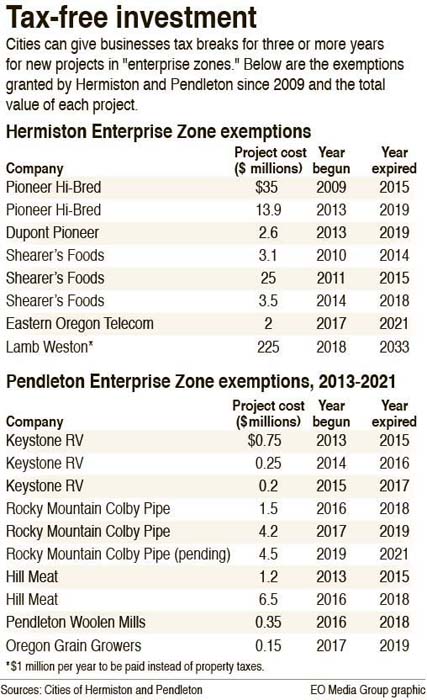Enterprise zones give significant tax breaks to local businesses
Published 1:20 pm Tuesday, January 23, 2018

- Enterprise zones give significant tax breaks to local businesses
Some of Eastern Oregon’s biggest businesses get a tax break only they can access, but it comes with a catch.
The enterprise zone, an Oregon program that provides multi-year property tax exemptions on new investments, has been utilized often by Hermiston over the past decade. Companies in certain industries located inside one of the zones can receive a three- to five-year exemption on property taxes for new construction or equipment, as long as the investment causes the company to add jobs or increase productivity.
From the beginning of Hermiston’s enterprise zone in 2005 until the end of 2017, the city gave enterprise zone tax exemptions to $85 million in capital investment. Those breaks exempted the companies — Shearer’s Foods, DuPont Pioneer, Pioneer Hi-Bred and Eastern Oregon Telecom — from paying any property taxes on the new construction or equipment for three to five years.
In early January, the city gave its first tax break longer than five years — known as a longterm rural enterprise agreement — to potato processor Lamb Weston. The company will not have to pay property taxes for 15 years on a $225 million project expanding its Hermiston plant. But in exchange for the longer tax break, the company has agreed to a $1 million per year payment to be split between the city of Hermiston and Umatilla County. Assistant city manager Mark Morgan said that $15 million spread over 15 years will equal about 42 percent of what Lamb Weston would have paid in property taxes over that same time period.
Tax breaks have since expired in Hermiston on $63.1 million worth of investments, bringing them onto the tax rolls. Another $3.5 million project by Shearer’s foods will come onto the tax rolls July 1.
Pendleton’s enterprise zone goes back much further, to at least 1997, but since 2013 has given breaks to $19.6 million in investments.
Morgan said it would be difficult for him to come up with even a ballpark number of how many dollars in property taxes had not been paid due to enterprise zone exemptions. The application lists the total amount of money the company is investing in the expansion, not what the building or new equipment will be appraised at. So, for example, Eastern Oregon Telecom was recently given an enterprise zone exemption on a $2 million investment, represented by the new building it broke ground on in September. But Morgan said he would guess roughly $400,000 of that investment would represent things like engineering and construction management, bringing the actual building’s appraised value to less than $2 million. Then there are formulas to calculate depreciation over time.
“It’s actually very hard to estimate how much the companies have saved on their tax bills based on the enterprise zone applications … these companies always list what they intend to invest, but the actual taxable value may be totally different,” he wrote in an email.
Morgan said it’s important to remember that once Hermiston got permission from the state to set up the enterprise zone, the regular exemption of three to five years (depending on jobs created) is automatic if a company turns in an application and has fulfilled all the requirements.
“If a company meets all of the requirements for a basic exemption, then it’s simply an administrative approval to check that they meet all of the requirements,” he said.
Proponents of the enterprise zone argue that a company simply won’t locate or expand anywhere that they can’t get a tax break, so a city that refuses to offer one will miss out on the jobs and other growth brought by the investment. A report compiled by Morgan at the end of the 2016-2017 fiscal year before the EOT and Lamb Weston tax breaks estimated the enterprise zone had resulted in “362 new full-time jobs resulting in more than $9.65 million of new annual payroll circulating through the economy of Hermiston and western Umatilla County as of 2016.”
Blue Mountain Community College’s taxing area spans throughout Eastern Oregon.
BMCC President Cam Preus said staff “haven’t put pen to paper” as to how much money enterprise zones exemptions cost the college, but the state helps supplement their general fund to stave off a loss in tax dollars.
Overall, Preus said the benefits of an enterprise zone outweighed the setbacks. She added that BMCC was invited to an upcoming meeting with the Umatilla County Board of Commissioners on how Lamb Weston’s $1 million annual payment will be spent, which could include funding for job training.





